This guide is a short presentation of Polish breeds, which are a constant part of Polish culture and history.
You will find information on the history of breed and its standard, and pictures showing the beauty of dogs.
Poland may be proud of fi ve dog breeds, four recognized by the FCI. These are: Polish Greyhound, Polish Hound, Polish Lowland Sheepdog, Tatra Shepherd Dog and Polish Hunting Dog.
The turbulent history of our country – partitions, the First and the Second World War, made the Polish breeds almost extinct. Fortunately painting, sculpture, and literature have captured them.
After the Second World War, thanks to breeders – enthusiastic cynologists associated in the Polish Kennel Club it was possible to reproduce them, and now we can be delighted with their beauty and admire their wisdom.
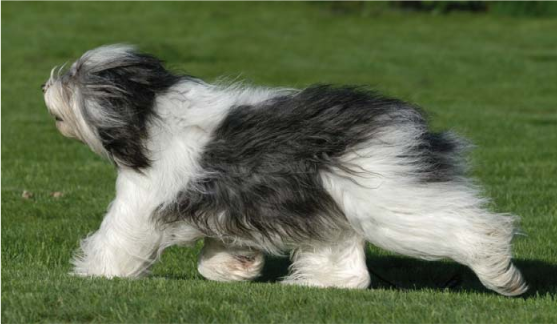
Polish Lowland Sheepdog (Polski Owczarek Nizinny)
FCI standard No 251
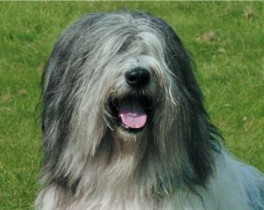
Well known in the world under the abbreviated name: “PON”. The history and appearance of the ancient sheepdogs are very little known. However they played an important role in herding sheep, so common in Europe in 17th, 18th and 19th century, they weren’t considered purebred dogs and nobody was interested in their exterior and systematic breeding.
Those hairy sheepdogs from European and Asian lowlands were usually of medium size, required by the type of their work. Small dogs wouldn’t command the respect of herded animals. It’s considered that their ancestor was a dog brought by the English from Asia and named the Tibetan Terrier. After years of selection the contemporary Tibetan Terrier has a little resemblance to his primitive ancestor. He became the show elegant with long, thick coat and extremely smooth movement. Thus, as Tatra Shepherd Dogs has their relatives in European mountains, our PONs are related to some breeds from European lowlands, such as: Dutch Schapendoes, Catalonian Sheepdog, Portuguese Sheepdog, Italian Bergamasco Shepherd or Hungarian Puli.
Before the World War II, since 1924, PONs began to appear on dog shows organized by the Polish Association for Purebred Dogs, as well as on agricultural exhibitions, among the livestock. They lived too, though still sparsely, in the cities, as companion dogs.
The humble beginnings became totally destroyed by the war. The breeding documentation got mislaid. But the PON survived, as traditional companion and helper of the farmer.
About the 1950 the group of activists from Bydgoszcz has undertaken eff orts to revive the breed. The dogs in similar type were searched and registered. The draft of the breed standard was drawn up by Maria Dubrowinowa. The standard of Polish Lowland Shepherd was approved by the FCI in 1965. Its current version dates from the year 1998.
In the sixties-seventies of the last century breeding PONs became a passion of Danuta Hryniewicz. One can’t fi nd in the world the PON without any ancestor with her kennel name: “z Kordegardy”. She was carrying her breeding lines with great knowledge and consistence.
The PONs were also under a special care of The Polish Kennel Club authorities. The PON breeders were for many years exempted from all charges, often even from show fees. It concerned also other native breeds, which were attempted to propagate.
Nowadays PON can be considered the most common Polish breed In the world. They are bred in France, Germany, Belgium, Finland, Denmark, Czech Republic, very numerous are in Great Britain as well as in United States. Several monographs of the breed has been published and translated into many languages.
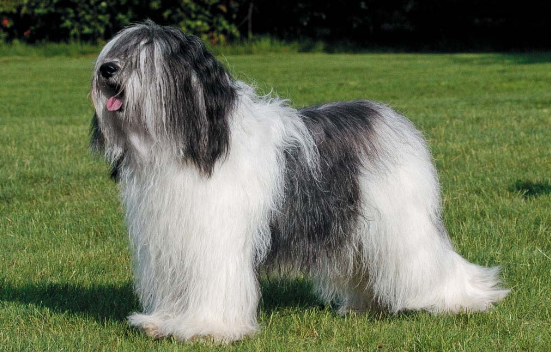
Polish Lowland Sheepdog – the shortened breed standard
The PON is a dog of medium size, slightly rectangular, strong and muscular. His most chara cteristic features are: smooth movement and long, thick coat. Well groomed coat gives him a very attractive appearance. Easy to train for herding tasks. Living in the city, can be a good companion and watchdog. PONs win hearts of their owners thanks to their high intelligence, tenderness and ability to fast learning. They are also resistant to unfavourable climatic conditions.
Height at the withers: males 45 – 50 cm; females: 42 – 47 cm. The head of medium size, not too heavy. The thick fur on the forehead, the chicks and the chin makes the head looking bigger than it really is. The ratio length of muzzle to length of skull is 1:1, yet the muzzle can be a little shorter. The skull not excessively broad, slightly rounded. The stop well accentuated. The nose large, as dark as possible in relation to the colour of the coat. Lips well fi tting, of the same colour as the nose.
Teeth strong, with scissor or pincer bite. The eyes of medium size, oval, of hazel colour. The rims of the eyelids should be well pigmented. Ears hanging, not too large, heart-shaped, close to the cheeks.
The neck of medium length, without dewlap, carried rather horizontally. The back fl at, the loin broad, the croup short, slightly truncated. The chest deep, of medium width.
The tail stumpy or short from birth or quite long and very hairy. At rest the tail is hanging; if the dog is alert, the tail is gaily curved over the back, but never curled or lying on the back. The forequarters of strong bone. The pastern slightly slanting. The forefeet oval, with toes tight and slightly arched. The hindquarters well angulated, seen from behind vertical, when standing and moving as well. Walk or trot smooth and parallel. The whole body is covered with dense, thick and coarse hair with soft undercoat. The hair straight, wavy hair acceptable. The hair falling from the forehead cover the eyes in characteristic manner. All colours are acceptable.
Polish Greyhound (Chart Polski)
FCI standard No 333
Already the 12th century chronicle of Gallus Anonymous contains mentions about the signifi cant expenses that the royal court beard for the main te nance of sighthounds. Hunting with them was the favorite enjoyment not only in magnate residences but also among the less well-off nobility.
The breed is descended probably from the ancient Asiatic sighthound Saluki, which in Arabic means: “the noble”. This theory is supported by the diversity of coat colours and the distribution of the length of the hair on the rear part of thighs and at the bottom of the tail.
During the hunt with greyhounds also falcons were often used. Dog task was to chase, catch and kill the game. They were accompanied by hunters on horseback. Usually the greyhounds didn’t retrieve and the hunter had to take them the prey after the chase, so it was necessary to keep dogs always in sight. The hunt was held on vast, open areas, so abundant in Poland that time.
The contemporary looks of the breed is a result of crosses between various types of greyhounds which occurred formerly in the territory of Poland.
When hunting the so called “leash”, i.e. two or three cooperating greyhounds, were used.
The image of the breed survived not only in literature but also in paintings of excellent Polish artists. The homogenous type of Polish Greyhounds depicted in painting proves that in spite of numerous crossings the breed has remained its proper appearance up to the end of 19th century. The Greyhounds painted precisely in the 19th century by the great painter Juliusz Kossak are identical with those presented on 17th century drawings of Abraham von Westerfelt, the portraitist of prince Janusz Radziwiłł.
At the end of the 19th century greyhounds became to be rare. The nobility was getting poor, the spacious hunting areas decreased, fi nally the tax had been imposed on greyhound owners. After the World War II they were held secretly by peasants, mainly in the regions of Kielce, Radom and Tarnobrzeg.
In 1971 Maciej Mroczkowski obtained information about Polish Greyhounds living in the territory of the USSR, in the Rostov region. The local hunters were using them to hunt hares. A group of fanciers decided to revive the breed and the breeding stock was imported. Yet it turned out that greyhounds had their enemies. There was a period when the authorities of Polish Kennel Club were refusing to register them, but they had also a large group of supporters among the cynologists. The fi rst breeders were showing their dogs on shows to popularizate the breed. In 1933 the valuable monograph of the breed by Małgorzata and Izabela Szmurło was published. Their kennel “Celerrimus” exists until now. The appendix to the studbook for the breed was opened in 1981. The breed standard was drawn up.
The FCI provisionally accepted the breed in Helsinki in 1989, at fi rst as not eligible for the CACIB. Nowadays hunting with sighthounds is forbidden in Poland but the Polish Greyhounds are very successful at track racing and lure coursing events.
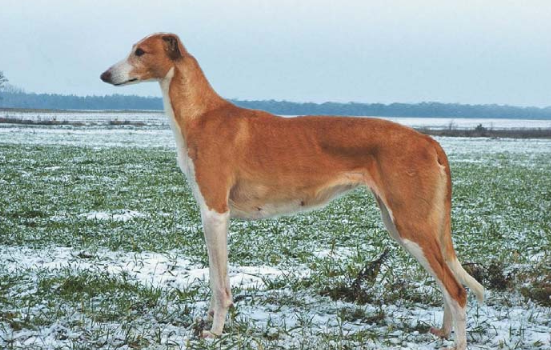
Polish Greyhound – the shortened breed standard
The Polish Greyhound is a dog of great size, muscular and powerful, defi nitely stronger than other short-haired sighthounds. The outline resembles the horizontal rectangle. The temperament brave and self-assured. On the run is fast, skilful and untiring.
The head strong, lean and long. The skull fl at. The stop and superciliary arches are lightly mar – ked. The nose black, large, projecting above the lips. The gentle “Romanesque profi le” is desired. Jaws strong, scissor bite, pincer bite acceptable. Eyes dark, expressive, rather large, set slightly oblique. The ears of medium size, quite narrow, of soft auricle. Should be rose-shaped, folded backwards but may also be carried in roof shape position, fully erect or with tips slightly bent forward.
The topline straight in the thoracic part and slightly arched in the lumbar region. The croup long, wide, gently slanting. The chest reaches the elbow. The tail long, feathered, with the tip curved in the shape of a sickle or forming a complete ring. On the move, the tail may be carried higher. The limbs long, lean, muscular, of moderate angulation. The movement fl owing, smooth and energetic. The sighthound led slowly may pace, but with acceleration of the speed, they should get back to normal diagonal movement. The narrow carrying of hindlegs isn’t considered a fault.
The Polish Greyhound is a shorthaired dog. The coat rather harsh, on the withers may be longer, shorter on the sides and legs. All colours are permitted.
Desired height at withers: 68-75 cm for the female and 70-80 cm for the male.
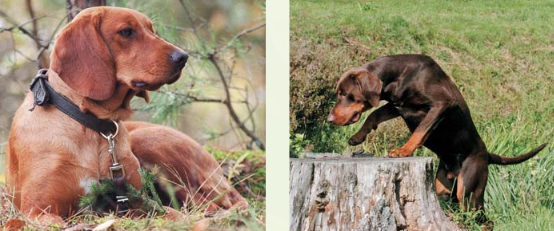
Polish Hunting Dog (Gończy Polski)
FCI standard No 354
Due to the complicated course of history, the breed reconstruction didn’t start before the eighties of the last century. At the beginning they were called: Hounds of colonel Józef Pawlusiewicz. Dogs of this breed were lighter built and smaller than Hounds of colonel Piotr Kartawik, bred in Wroclaw. Other diff erence was the black and tan coat colour, with the black colour always overlapping the head.
Long before the World War II they were kept by the family of Józef Pawlusiewicz in the region of Bieszczady mountains. After the war colonel Pawlusiewicz continued breeding hounds with the kennel name: “z Karpat”, using dogs inherited from his father, which survived the war. He was also searching suitable dogs at hunters in southern Poland: in Bieszczady mountains and in the region of Podkarpacie. Initially he lived in Bieszczady, later moved to Chynów near Warsaw.
His work met with diffi culties because at the same time in Wroclaw were bred hounds in the type of colonel Kartawik: stronger, bigger and of saddle tan coat colour. Soon their breed standard were drawn and already in 1966 they were registered by the FCI as: “the Polish Hound”. The hounds of colonel Pawlusiewicz, smaller and with diff erent coat colour, didn’t meet requirements of that standard. It was proved by the biometric measurements, conducted in Warsaw in 1968 and then in the years 1982-1983. They showed a vast diff erence between those two types of hounds.
The smaller might became forgotten if not the keen breeders who appreciated a lot their outstanding skills for wild boar hunting and tracking down the wounded game. Those breeders were still keeping them, as dogs without documents. Until 1982 the hunters were trying to cross both types, but without satisfactory results. In 1983 the plenary meeting of the Polish Kennel Club decided to open the stud book for this excluded group of dogs under the name: gończy polski (Polish Hunting Dog). In the same year doctor Kazimierz Ściesiński drew up the breed standard. It took many years to fi x the breed mental features and to form its present appearance. It wouldn’t be possible without the arduous work of the breeders and they are the authors of the current success of the breed. After meeting all requirements, the standard of the Polish Hunting Dog became approved by the FCI. Now Polish Hunting Dogs are more nume rous than Polish Hounds. They are be frequently met in cities, kept as companion dogs by families not interested in hunting. The hunters appreciate a lot their endurance and great abilities to track down and chase the game.
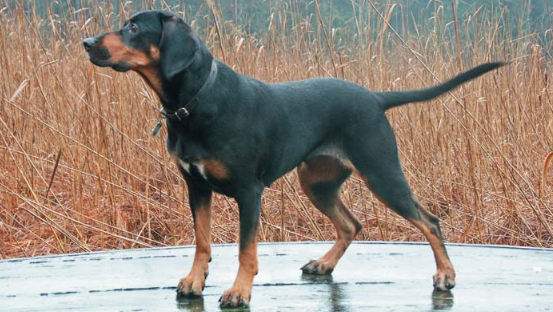
Polish Hunting Dog – the shortened breed standard
The native polish breed, found nowadays within the whole Polish territory. Especially appreciated by hunters from mountain areas of Bieszczady, Beskidy, Pieniny and the Podhale region. Used for hunting wild boar and deer, less often for the small game: hares and foxes. Characterized by the melodious barking, with the pitch changing during the chase. Very courageous, easy to train, stable and intelligent. The wariness towards strangers makes him a good watchdog.
The body construction is compact and quite light. The rectangular body (ratio 9:10) and medium size not exceeding 59 cm, together with the high mobility and nimbleness predestine him to his working tasks.
The head noble, the skull slightly convex, of the same length as the muzzle. The stop slightly pronounced.
The nose black. The lips fl eshy, with a slight fold at the commissure. Scissor bite, the complete dentition desired. The eyes medium sized, distinctly oblique and as dark as possible in relation to the colour of the coat. The eyelids shouldn’t drop. The ears of medium size, hanging, set at the level of the external angle of the eye. Their front edge hangs close to the cheek.
The neck strong, of medium length, without a dewlap. The back straight, the withers defi ned, the loin broad. The chest reaches the elbows. The tail well covered with hair, with slight brush, carried sabre-like; when dog is alert carried slightly above the topline. The limbs strong, upright, well angulated. The feet tight and oval.
The hair on the body is harsh, rigid and lying close to the skin. Dense undercoat. On the head and ears the hair is short and silky. The coat colours: black and tan – the tan, being the combination of brown and red, should be well distinct from the black; chocolate and tan and red of various shades. Small white marks on toes and chest are not considered as a fault.
Polish Hound (Ogar Polski)
FCI Standard No 52
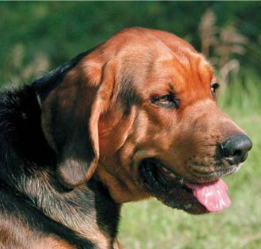
There is an old tradition of hunting with hounds in Poland. It’s described in numerous publications and probably the most valuable of them is the work: “Hunting with hounds” from the year 1611, written by count Jan Ostroróg. Ostroróg, who was an eminent connoisseur of Polish Hounds and the hunt, describes their mental characteristics, working abilities, methods of hunting, details of the chase, types of dog voices, hunting signals and naming of Polish Hounds. Unfortunately this work does not include information about the appearance of Polish Hounds. Evidently, they were so widely known that the author didn’t consider necessary to describe their exterior.
That time the Polish Hound and the Polish Hunting Dog were considered to be the one type. In the ancient Poland they were used to hunt all kinds of big and small game: deer, roe-deer, bears, badgers, foxes, hares etc. The hounds was able also to fl ush out wild ducks from rushes. Their task was to track down the game, fl ush it out and guide it on the shot.
The Polish Hounds have a characteristic way of barking, described by hunters as: “playing”. They bark on the hot trail and stop playing when they lose it. An experienced hunter listening his dogs, knows how far they are from the game and even what kind of game is chased.
Watching the fi rst images, one can conclude that the Polish Hound was derived from or related to the Bloodhound, which from the time of the Crusades had the strong impact on the French large-sized hounds. All the breeds of scenthounds which developed then in Western Europe were descended from dogs brought from Asia Minor. During the conquest of Russia by the Tartars in 13th and 14th century, they were brought by the invaders to Eastern Europe. Today it’s diffi cult to reconstruct the way in which that dog has reached Poland.
The late 19th century the breed were thought to become extinct in spite of its highly appreciated hunting skills. It happened as a result of wars, partitions of the country, decrease of hunting areas and, above all, due to widespread use of fi rearms. The hounds became than useful to vocalize the chased game. Besides the Polish Hound, there were described some smaller and lighter varieties of the coat black and tan, red, or yellow with white markings.
The Polish Hound images can be found in the 19th century paintings, presenting generally the shorthaired dogs.
After the World War I there were no Polish Hound kennels in Poland. Until 1939 they were still kept in Lithuania, where they have their standard, stud book and were known as: “Polish-Russian Hound”. Later the hunters from the region of Wołyń and Vilnius continued the breeding, calling their dogs: “Polish Hounds”. In 1959 colonel Piotr Kartawik, of Lithuanian descent, brought to Wrocław the fi rst Polish Hounds from the Belarusian kennel in the region of Nowogródek. Colonel Kartawik established his own kennel “z Kresów” (“from the Borderlands”). The breed standard was prepared already in 1964 and in 1966 became registered by the FCI.
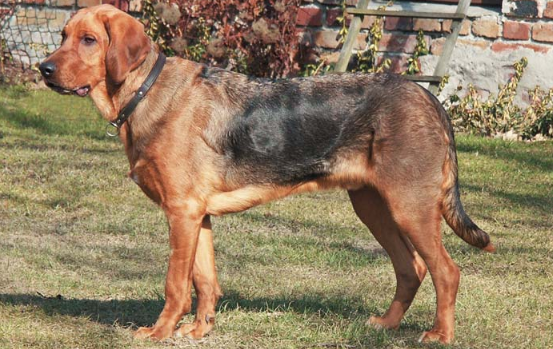
Polish Hound – the shortened breed standard
Medium size dog, of strong, rather heavy build. The outline rectangular. The head quite heavy, the skull wide, the forehead wrinkled, the stop well defi ned. The nose large and dark. The muzzle deep, of the same length as the skull, truncated at the tip. Upper lips thick and drooping, lip corners turning up in folds. Teeth strong and white, meeting in a scissor bite. The eyes dark brown, slightly slanting; lower lid might drop in older dogs. The ears set quite low, twisted towards cheeks and hanging close to them. The neck quite thick, with a dewlap. The back long, broad, the loin compact. The croup muscular, quite long, slightly rounded. The chest deep. The tail rather low set, in slow movement slightly raised but not rolled up. While chasing, the dog carries the tail below the topline and turns it slightly aside. The limbs well angulated, the feet tight and strong. Strong bone.
The most characteristic gait is a slow trot; while chasing not very fast gallop. Endurance is one of his most characteristic features.
The hair on the head, ears and limbs short and smooth. On other parts of body of medium length, thick and hard. A little longer on the nape, buttocks and on lower part of the tail.
The Polish Hound captivates with his characte ri stic coat colour. The head and ears are black and tan. The ears are always darker coloured. The limbs and underbelly are also tanned, in the shade from dark yellow to mahogany. Black or dark grey hair form a saddle on the whole nape, overlapping the back of the head, cover completely the back, both sides of the body and the top of the tail. Permissible are: the white blaze on the head and the nose bridge, white spot on the chest, white extremities of legs and the white tip of the tail.
The height at withers for males is 56-65 cm, for females 55-60 cm.
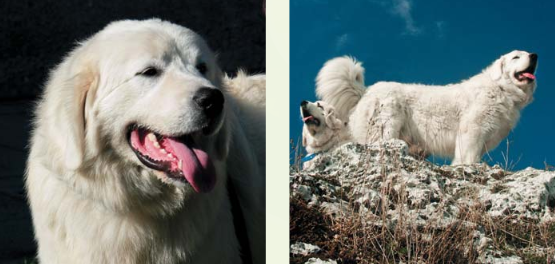
Tatra Shepherd Dog (Polski Owczarek Podhalański)
FCI standard No 252
Tatra Shepherd Dog represents mountain dogs, descended from the Tibetan Mastiff . Related with and similar to some other breeds of shepherd dogs used in Europe along the Carpathians, the Alps and the Pyrenees. This family includes Hungarian Kuvasz, Slovakian Chuvach, Italian Maremma and the Abruzzes Sheepdog and the Pyrenean Mountain Dog.
Abroad known as: Chien de Tatra, Tatra Shepherd Dog or Tatrahund. This impressive dog was the most common in the Podhale region. Well known to tourists visiting Zakopane, our famous mountain resort, and other villages of that region. Souvenir photos of a highlander in the traditional costume with his sheepdog can be found in many old family albums. The highlanders were using their dogs to guard sheep on sub-mountain pastures, to defend them against wolves and robbers and, most frequently, as watchdogs guarding the farmyards. This rule is fulfi lled by them until now.
The breeders were selecting white dogs to distinguish them easily from the bear or wolf and to make them well visible at dusk.
In the thirties of the last century the breed was actively promoted in accordance with the slogan: “Polish dog in Polish home”. The Working Dog Lovers Society adopted Tatra Shepherd Dog as one of its breeds. Dogs of this breed were introduced in an urban environment and became widespread across all the country. They were attempted to use by the border guard, the army, as a guide dog and rescue dog, especially in the mountain rescue. Tatra Shepherd Dogs became to be bought also in the lowlands by owners of houses with garden, suburban residences or manors. The breed was becoming fashionable but it suff ered a lot during the World War II, as all the livestock in Poland.
The breed standard, originally established in 1937, was amended several times. The last version is from the year 1988. Nowadays the Tatra Shepherd Dog can be found not only within all territory of Poland but also abroad. His stylized silhouette adorns the emblem of the Polish Kennel Club.
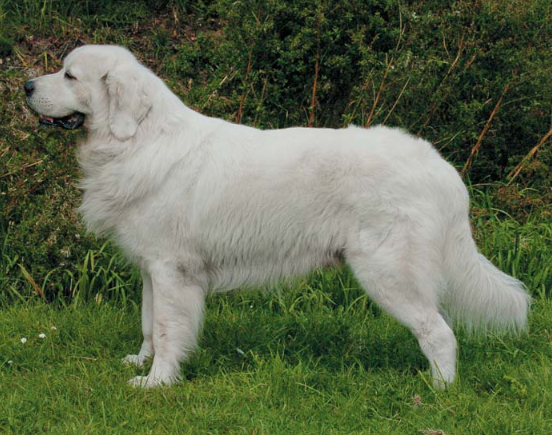
Tatra Shepherd Dog – the shortened breed standard
The dog of strong, compact build, giving the impression of stamina and mobility. Calm, intelligent and alert; easy to train. The most important is to bear in mind his working abilities, for which the breed was shaped by centuries.
Height at withers for males: 65-70 cm, for females: 60-65 cm. The outline rectangular. The head of proportional size, lean and strong but not too heavy, in harmony with the body. Should be carried proudly but not too high. The skull slightly rounded, the stop distinctly marked but without abrupt break. The muzzle strong, with broad nasal bridge and black nose. The teeth strong, meeting in a scissors bite. The pincer bite is accepted. The eyes of medium size, dark brown, with dark eyelids. The ears of medium length, rather thick, triangular, well furnished with hair, with the front edge hanging close to the head, set at the height of the external angle of the eyes or a little higher.
The neck muscular, without any dewlap, with a profuse mane. The back level and broad, of medium length, the croup slightly sloping. The chest deep, the belly slightly tucked up. The tail set on not too high, carried below the topline. When the dog is excited raises the tail above the topline but doesn’t curve it.
The forequarters muscular, of strong bone, but not too heavy; seen from front straight. The hindquarters set slightly backwards, moderately angulated. The hair on head, front part of forelegs and hindlegs, from the hock downward, is short and dense. The neck and body are covered with long, thick, straight or slightly wavy hair. The hair should be hard to the touch, with dense undercoat. The tail profusely coated. The colour uniformly white, any traces or patches of creamy or other colours are undesirable. Darker skin on the muzzle and around nostrils is appreciated, as it shows good pigmentation.
